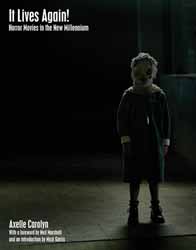|
Click here to return to the main site. Book Review
A comprehensive analysis and overview of the state of horror cinema at the start of the 21st Century. Axelle Carolyn discusses and dissects films from the Asian remake trend of The Ring and The Grudge to the so-called torture porn of the Saw and Hostel series, taking in independents and foreign productions as well as the blockbusters. Fully illustrated in full colour, It Lives Again! is your definitive guide to modern cinematic horror... It’s Alive Again is a large format (if not particularly thick) hardcover book, on good quality paper with plenty of colour photos, which studies the cinematic and straight to DVD horror releases of the new millennium (from 2000 to 2008). It is written by Axelle Carolyn, who has conducted reviews for a number of publications and has now moved into fiction writing and even acting. Her writer/director husband Neil Marshall writes the introduction, and Masters of Horror creator and long-time Stephen King film collaborator Mick Garris pens the foreword. Neither the Introduction or Foreword make for riveting reading, so I wasn’t in the most positive frame of mind to start digesting the book as a whole. Carolyn begins by recapping on nineties successes such as Japanese or J-Horror, The Sixth Sense, The Blair Witch Project and the John Carpenter titles In The Mouth of Madness and Vampires. There is an attempt to convince her readership that horror films reflect the state of society at the time. I’ve always considered this association to be a load of dingo's kidneys (as Douglas Adams would have said). There is no convincing proof that the content or style of a movie originates from the current world at large; only that different people have varying tastes (for example, buckets of blood or a spooky supernatural tale, teen horror or monster movie). The only concession I’m prepared to make in this respect is that the media in particular finds it easy to blame certain horror films for society’s own inadequacies. Banning one release is a much simpler process than tackling the problem head-on. It’s more accurate to say that (like metal music) horror incorporates many formats and categories, and that these will fall in and out of favour over time, often going in circles with minor evolutionary changes each time. Those who have not explored the genre will inevitably condemn or criticise the entire bag. Fortunately, Carolyn appears to quickly drop this approach to the releases of the last few years, instead settling down to briefly describing the major news events of the year at the beginning of each chapter. Thereafter, not surprisingly considering the writer’s professional roots, the remainder of each section of the book consists of a series of truncated reviews strung together as a sort of commentary, so that we learn the budget, opening financial take, the number of cinemas it was shown at, and an opinion of the film’s merits - along with a sentence or two about the relevant director. Although the writer could have had more fun with this book, the reviews are the most enjoyable parts to read. Many keen horror fans such as myself would already know much of the information revealed in this book, but for me its greatest merit is that it reminded me again of several films I had forgotten, and more than one or two I seem to have missed (shame on you Mr Editor). Of course, there are also those that should be forgotten by the industry and everyone else. Personal favourites from this period include: Final Destination, 28 Days Later, Dog Soldiers, the original version of The Eye, Switchblade Romance, May, Dead End, Bubba Ho-Tep, Seed of Chucky, Saw, The Machinist, Masters of Horror, The Ordeal, Pulse, The Orphanage and a few others I'm sure I've forgotten. 7 Ty Power Buy this item online |
|---|


